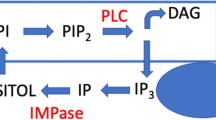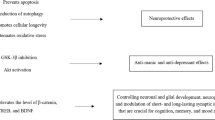Abstract
Brain-derived neurotrophic factor (BDNF) and B-cell lymphoma-2 (Bcl-2) proteins are neuroprotective factors involved in neuronal signaling, survival and plasticity. Both can be regulated by cyclic AMP response element binding (CREB) protein. Decreased levels of BDNF and Bcl-2 are implicated in the pathogenesis of bipolar disorder. The present study investigated whether chronically administered mood stabilizers would increase BDNF and/or Bcl-2 levels in rat brain. Real time RT-PCR, sandwich ELISA and Western blotting were used to measure BDNF and Bcl-2 mRNA and protein levels in the frontal cortex of rats chronically administered carbamazepine (CBZ) or lamotrigine (LTG) to produce plasma concentrations therapeutically relevant to bipolar disorder. Chronic CBZ and LTG significantly increased BDNF and Bcl-2 mRNA and protein levels in the frontal cortex. A common mechanism of action of mood stabilizers in the treatment of bipolar disorder may involve neuroprotection mediated by upregulation of brain BDNF and Bcl-2 expression.


Similar content being viewed by others
Abbreviations
- AP-2:
-
Activator protein-2
- BDNF:
-
Brain derived neurotrophic factor
- Bcl-2:
-
B-cell lymphoma-2
- BD:
-
Bipolar disorder
- CBZ:
-
Carbamazepine
- CREB:
-
cAMP response element binding protein
- LTG:
-
Lamotrigine
- pCREB:
-
Phosphorylated CREB
References
Chalovich EM, Zhu JH, Caltagarone J, Bowser R, Chu CT (2006) Functional repression of cAMP response element in 6-hydroxydopamine-treated neuronal cells. J Biol Chem 281:17870–17881. doi:10.1074/jbc.M602632200
Chuang DM (2005) The antiapoptotic actions of mood stabilizers: molecular mechanisms and therapeutic potentials. Ann NY Acad Sci 1053:195–204. doi:10.1196/annals.1344.018
Webster MJ, Herman MM, Kleinman JE, Shannon Weickert C (2006) BDNF and trkB mRNA expression in the hippocampus and temporal cortex during the human lifespan. Gene Expr Patterns 6:941–951. doi:10.1016/j.modgep.2006.03.009
Jarskog LF, Selinger ES, Lieberman JA, Gilmore JH (2004) Apoptotic proteins in the temporal cortex in schizophrenia: high Bax/Bcl-2 ratio without caspase-3 activation. Am J Psychiatry 161:109–115. doi:10.1176/appi.ajp.161.1.109
Finkbeiner S (2000) CREB couples neurotrophin signals to survival messages. Neuron 25:11–14. doi:10.1016/S0896-6273(00)80866-1
Jarskog LF, Gilmore JH, Selinger ES, Lieberman JA (2000) Cortical Bcl-2 protein expression and apoptotic regulation in schizophrenia. Biol Psychiatry 48:641–650. doi:10.1016/S0006-3223(00)00988-4
Dean B, Gray L, Scarr E (2006) Regionally specific changes in levels of cortical S100beta in bipolar 1 disorder but not schizophrenia. Aust N Z J Psychiatry 40:217–224. doi:10.1111/j.1440-1614.2006.01777.x
Knable MB, Barci BM, Webster MJ, Meador-Woodruff J, Torrey EF (2004) Molecular abnormalities of the hippocampus in severe psychiatric illness: postmortem findings from the Stanley Neuropathology Consortium. Mol Psychiatry 9:609–620 544
Lyoo IK, Sung YH, Dager SR, Friedman SD, Lee JY, Kim SJ et al (2006) Regional cerebral cortical thinning in bipolar disorder. Bipolar Disord 8:65–74. doi:10.1111/j.1399-5618.2006.00284.x
Gray NA, Du J, Falke CS, Yuan P, Manji HK (2003) Lithium regulates total and synaptic expression of the AMPA glutamate receptor GluR2 in vitro and in vivo. Ann NY Acad Sci 1003:402–404. doi:10.1196/annals.1300.036
Rajkowska G (2002) Cell pathology in bipolar disorder. Bipolar Disord 4:105–116. doi:10.1034/j.1399-5618.2002.01149.x
Calabrese JR, Rapport DJ, Youngstrom EA, Jackson K, Bilali S, Findling RL (2005) New data on the use of lithium, divalproate, and lamotrigine in rapid cycling bipolar disorder. Eur Psychiatry 20:92–95. doi:10.1016/j.eurpsy.2004.12.003
Bachmann RF, Schloesser RJ, Gould TD, Manji HK (2005) Mood stabilizers target cellular plasticity and resilience cascades: implications for the development of novel therapeutics. Mol Neurobiol 32:173–202. doi:10.1385/MN:32:2:173
Einat H, Yuan P, Gould TD, Li J, Du J, Zhang L et al (2003) The role of the extracellular signal-regulated kinase signaling pathway in mood modulation. J Neurosci 23:7311–7316
Chen G, Zeng WZ, Yuan PX, Huang LD, Jiang YM, Zhao ZH et al (1999) The mood-stabilizing agents lithium and valproate robustly increase the levels of the neuroprotective protein Bcl-2 in the CNS. J Neurochem 72:879–882. doi:10.1046/j.1471-4159.1999.720879.x
Dager SR, Friedman SD, Parow A, Demopulos C, Stoll AL, Lyoo IK et al (2004) Brain metabolic alterations in medication-free patients with bipolar disorder. Arch Gen Psychiatry 61:450–458. doi:10.1001/archpsyc.61.5.450
Soares JC, Kochunov P, Monkul ES, Nicoletti MA, Brambilla P, Sassi RB et al (2005) Structural brain changes in bipolar disorder using deformation field morphometry. Neuroreport 16:541–544. doi:10.1097/00001756-200504250-00004
Ghelardoni S, Tomita YA, Bell JM, Rapoport SI, Bosetti F (2004) Chronic carbamazepine selectively downregulates cytosolic phospholipase A2 expression and cyclooxygenase activity in rat brain. Biol Psychiatry 56:248–254. doi:10.1016/j.biopsych.2004.05.012
Ahmad S, Fowler LJ, Whitton PS (2004) Effects of acute and chronic lamotrigine treatment on basal and stimulated extracellular amino acids in the hippocampus of freely moving rats. Brain Res 1029:41–47. doi:10.1016/j.brainres.2004.09.016
Rao JS, Rapoport SI, Bosetti F (2005) Decrease in the AP-2 DNA-binding activity and in the protein expression of AP-2 alpha and AP-2 beta in frontal cortex of rats treated with lithium for 6 weeks. Neuropsychopharmacology 30:2006–2013. doi:10.1038/sj.npp.1300740
Rao JS, Ertley RN, Lee HJ, Rapoport SI, Bazinet RP (2006) Chronic fluoxetine upregulates activity, protein and mRNA levels of cytosolic phospholipase A2 in rat frontal cortex. Pharmacogenomics J 6:413–420. doi:10.1038/sj.tpj.6500391
Rao JS, Ertley RN, Lee HJ, DeMar JC Jr, Arnold JT, Rapoport SI et al (2007) n-3 polyunsaturated fatty acid deprivation in rats decreases frontal cortex BDNF via a p38 MAPK-dependent mechanism. Mol Psychiatry 12:36–46. doi:10.1038/sj.mp.4001888
Chen RW, Chuang DM (1999) Long term lithium treatment suppresses p53 and Bax expression but increases Bcl-2 expression a prominent role in neuroprotection against excitotoxicity. J Biol Chem 274:6039–6042. doi:10.1074/jbc.274.10.6039
Chen B, Wang JF, Hill BC, Young LT (1999) Lithium and valproate differentially regulate brain regional expression of phosphorylated CREB and c-Fos. Brain Res Mol Brain Res 70:45–53. doi:10.1016/S0169-328X(99)00125-4
Yasuda S, Liang MH, Marinova Z, Yahyavi A, Chuang DM (2007) The mood stabilizers lithium and valproate selectively activate the promoter IV of brain-derived neurotrophic factor in neurons. Mol Psychiatry (in press)
Einat H, Manji HK, Gould TD, Du J, Chen G (2003) Possible involvement of the ERK signaling cascade in bipolar disorder: behavioral leads from the study of mutant mice. Drug News Perspect 16:453–463. doi:10.1358/dnp.2003.16.7.829357
Mai L, Jope RS, Li X (2002) BDNF-mediated signal transduction is modulated by GSK3beta and mood stabilizing agents. J Neurochem 82:75–83. doi:10.1046/j.1471-4159.2002.00939.x
Rajkowska G (2000) Postmortem studies in mood disorders indicate altered numbers of neurons and glial cells. Biol Psychiatry 48:766–777. doi:10.1016/S0006-3223(00)00950-1
Laifenfeld D, Karry R, Klein E, Ben-Shachar D (2005) Alterations in cell adhesion molecule L1 and functionally related genes in major depression: a postmortem study. Biol Psychiatry 57:716–725. doi:10.1016/j.biopsych.2004.12.016
Okada T, Hashimoto R, Numakawa T, Iijima Y, Kosuga A, Tatsumi M et al (2006) A complex polymorphic region in the brain-derived neurotrophic factor (BDNF) gene confers susceptibility to bipolar disorder and affects transcriptional activity. Mol Psychiatry 11:695–703. doi:10.1038/sj.mp.4001822
Rybakowski JK, Borkowska A, Skibinska M, Szczepankiewicz A, Kapelski P, Leszczynska-Rodziewicz A et al (2006) Prefrontal cognition in schizophrenia and bipolar illness in relation to Val66Met polymorphism of the brain-derived neurotrophic factor gene. Psychiatry Clin Neurosci 60:70–76. doi:10.1111/j.1440-1819.2006.01462.x
DeMar JC Jr, Ma K, Bell JM, Igarashi M, Greenstein D, Rapoport SI (2006) One generation of n-3 polyunsaturated fatty acid deprivation increases depression and aggression test scores in rats. J Lipid Res 47:172–180. doi:10.1194/jlr.M500362-JLR200
Rao JS, Ertley RN, DeMar JC Jr, Rapoport SI, Bazinet RP, Lee HJ (2007) Dietary n-3 PUFA deprivation alters expression of enzymes of the arachidonic and docosahexaenoic acid cascades in rat frontal cortex. Mol Psychiatry 12:151–157. doi:10.1038/sj.mp.4001887
Garrido R, Springer JE, Hennig B, Toborek M (2003) Apoptosis of spinal cord neurons by preventing depletion nicotine attenuates arachidonic acid-induced of neurotrophic factors. J Neurotrauma 20:1201–1213. doi:10.1089/089771503322584628
Rao JS, Lee HJ, Rapoport SI, Bazinet RP (2008) Mode of action of mood stabilizers: is the arachidonic acid cascade a common target? Mol Psychiatry 13:585–596. doi:10.1038/mp.2008.31
Abramson SB, Leszczynska-Piziak J, Weissmann G (1991) Arachidonic acid as a second messenger Interactions with a GTP-binding protein of human neutrophils. J Immunol 147:231–236
Kwon KJ, Jung YS, Lee SH, Moon CH, Baik EJ (2005) Arachidonic acid induces neuronal death through lipoxygenase and cytochrome P450 rather than cyclooxygenase. J Neurosci Res 81:73–84. doi:10.1002/jnr.20520
Tang DG, Chen YQ, Honn KV (1996) Arachidonate lipoxygenases as essential regulators of cell survival and apoptosis. Proc Natl Acad Sci USA 93:5241–5246. doi:10.1073/pnas.93.11.5241
Arita K, Kobuchi H, Utsumi T, Takehara Y, Akiyama J, Horton AA et al (2001) Mechanism of apoptosis in HL-60 cells induced by n-3 and n-6 polyunsaturated fatty acids. Biochem Pharmacol 62:821–828. doi:10.1016/S0006-2952(01)00723-7
Duman RS, Malberg J, Nakagawa S, D’Sa C (2000) Neuronal plasticity and survival in mood disorders. Biol Psychiatry 48:732–739. doi:10.1016/S0006-3223(00)00935-5
Wajapeyee N, Britto R, Ravishankar HM, Somasundaram K (2006) Apoptosis induction by activator protein 2{alpha} involves transcriptional repression of Bcl-2. J Biol Chem 281:16207–16219. doi:10.1074/jbc.M600539200
Rao JS, Bazinet RP, Rapoport SI, Lee HJ (2007) Chronic administration of carbamazepine down-regulates AP-2 DNA-binding activity and AP-2alpha protein expression in rat frontal cortex. Biol Psychiatry 61:154–161. doi:10.1016/j.biopsych.2006.03.029
Lyons WE, Mamounas LA, Ricaurte GA, Coppola V, Reid SW, Bora SH et al (1999) Brain-derived neurotrophic factor-deficient mice develop aggressiveness and hyperphagia in conjunction with brain serotonergic abnormalities. Proc Natl Acad Sci USA 96:15239–15244. doi:10.1073/pnas.96.26.15239
Monteggia LM, Luikart B, Barrot M, Theobold D, Malkovska I, Nef S et al (2007) Brain-derived neurotrophic factor conditional knockouts show gender differences in depression-related behaviors. Biol Psychiatry 61:187–197. doi:10.1016/j.biopsych.2006.03.021
Koponen E, Rantamaki T, Voikar V, Saarelainen T, MacDonald E, Castren E (2005) Enhanced BDNF signaling is associated with an antidepressant-like behavioral response and changes in brain monoamines. Cell Mol Neurobiol 25:973–980. doi:10.1007/s10571-005-8468-z
Acknowledgements
This work was entirely supported by the Intramural Research Program of the National Institute on Aging, National Institutes of Health. We thank the National Cancer Institute (NCI), Center for Cancer Research (CCR) Fellows Editorial Board, for proofreading the manuscript.
Author information
Authors and Affiliations
Corresponding author
Rights and permissions
About this article
Cite this article
Chang, Y.C., Rapoport, S.I. & Rao, J.S. Chronic Administration of Mood Stabilizers Upregulates BDNF and Bcl-2 Expression Levels in Rat Frontal Cortex. Neurochem Res 34, 536–541 (2009). https://doi.org/10.1007/s11064-008-9817-3
Received:
Accepted:
Published:
Issue Date:
DOI: https://doi.org/10.1007/s11064-008-9817-3




